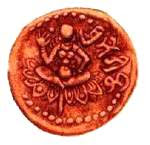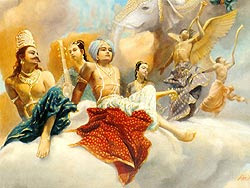Her appearance on coins (as shown here) is of a female in the popular meditation pose of Buddhists and Jain ascetics atop a lotus. This imagery is widespread in Shramanic ("wandering ascetic") and Brahmanical traditions, which adopted many of the motifs and ambitions of this populist new wave of religious expression away from priests and temples to actually attained individuals. (This echoes what was to happen in Israel centuries later when the vibrant Shramana Jesus (just back from India) took on the staid established Jewish orthodoxy and caused a revolution that continues to influence the West.
 Like Krishna, a historical figure elevated to mythic proportions, the move from her origins in history to being associated with Lakshmi are not accidental. It behooves institutions to adopt popular traits and integrate them with established figures for fear of being displaced by them.
Like Krishna, a historical figure elevated to mythic proportions, the move from her origins in history to being associated with Lakshmi are not accidental. It behooves institutions to adopt popular traits and integrate them with established figures for fear of being displaced by them.Another example is the Indian god (deva-raja) Indra,* who like Zeus or Thor is imagined to hurl lightning bolts in the sky. It is well known that Indra is in fact an amalgamation of the pre-Vedic and Vedic gods. And Buddhists refer to Indra as and Śakra (Pali, Sakka), the "king of the devas" who is at war in the heavens with the Asuras. He therefore has come to be regarded as the "god of war" as if he were more than a deva ("godling") or for war.
The Uppalavana/Lakshmi figure is seen on coins of Saurashtra Janapada, local coins in Buddhist and formerly Buddhist part of the Indian empire: Kausambi, Ujjain, Mathura, Ayodhya, Kashmir, Sri Lanka , Nepal, and coins of Yaudheya, Kuninda , Arjunayana, Agodaka.
The popularity of this goddess transcended the religious beliefs of the issuers like Azilises and Mohd Ghauri.
Who was the Vedic Lakshmi?
Ananda Coomaraswamy believes that Aditi is analogous with Lakshmi. She is Great Mother (Mahi-Mata) the imperishable goddess. She is the mother (or sister) of Adityas (including Mitra and Varuna) and daughter (or mother) of Daksha. The honorific "Sri" (a noun and adjective) is used in Rig Veda and also in Avestan literature to denote "that which is beautiful." The word Lakshmi first appears in Rig Veda in the sense of an auspicious or pleasant quantity. Her origin is traced to fifteen verses known as the Hymn to Sri (Sri-sukta) found appended to the regular collection of hymns of the Fifth Book of the Rig Veda.
Ananda Coomaraswamy believes that Aditi is analogous with Lakshmi. She is Great Mother (Mahi-Mata) the imperishable goddess. She is the mother (or sister) of Adityas (including Mitra and Varuna) and daughter (or mother) of Daksha. The honorific "Sri" (a noun and adjective) is used in Rig Veda and also in Avestan literature to denote "that which is beautiful." The word Lakshmi first appears in Rig Veda in the sense of an auspicious or pleasant quantity. Her origin is traced to fifteen verses known as the Hymn to Sri (Sri-sukta) found appended to the regular collection of hymns of the Fifth Book of the Rig Veda.
The Rig Vedic hymns of Sri Sukta associate her with the lotus. It describes her as Padma Sthite ("stands on lotus"), Padmavasa or Padmagriha (residing in a lotus). Hiranyavarnam (one who shines like gold reminiscent of Uppalavanna's skin tone), Adityavarnam/Pingala ("radiant as the sun"/"yellow in hue"), Hemamalini ("wearing a gold garland"), Chandram ("blossoming like the moon"), Suvarna ("whose luster is that of burnished gold"), Devajushtam ("worshipped by devas"). She is blazing with splendor, and is the embodiment of the fulfillment of all wishes. She is said to drive out all misfortune and poverty. She is unfailing and blesses with wealth and plenty, not only gold but also cattle, servants, horses, and men.
Indra/Sakka
 *INDRA: in Hindu mythology, the "king of the gods." He is one of the main gods of the archaic Sanskrit collection of hymns, the Rigveda, and is the Indo-European cousin of the German Wotan, Norse Odin, Greek Zeus, and Roman Jupiter.
*INDRA: in Hindu mythology, the "king of the gods." He is one of the main gods of the archaic Sanskrit collection of hymns, the Rigveda, and is the Indo-European cousin of the German Wotan, Norse Odin, Greek Zeus, and Roman Jupiter.The Rig-Veda frequently refers to him as Śakra -- the mighty-one. In the Vedic period, the number of gods was assumed to be thirty-three and Indra was their lord. (The slightly later Brihad-aranyaka Upanishad enumerates the gods as the eight Vasus, the eleven Rudras, the twelve Adityas, Indra, and Prajapati). As lord of the Vasus, Indra was also referred to as Vāsava.
By the age of the Vedanta, Indra became the prototype for all lords and thus a king could be called Mānavendra (Indra or "lord of men") and Rama, the hero of the Ramayana, was referred to as Rāghavendra ("Indra of the clan of Raghu").
Hence the original Indra was also referred to as Devendra ("Indra of the Devas"). However, Sakra and Vasava were used exclusively for the original Indra. Though, modern texts usually adhere to the name Indra, the traditional Hindu texts (the Vedas, epics, and Puranas) use Indra, Sakra, and Vasava interchangeably and with the same frequency. "Of the Vedas I am the Sama Veda; of the demigods I am Indra, the king of heaven; of the senses I am the mind; and in living beings I am the living force [consciousness]" (Bhagavad Gita 10.22).
































































































































































































































No comments:
Post a Comment